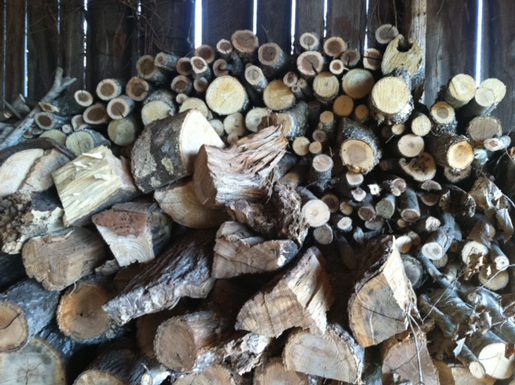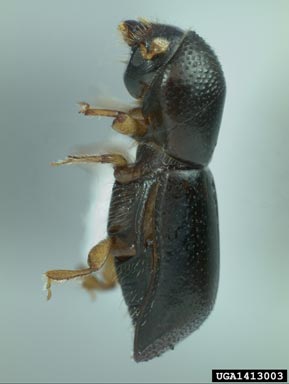Save local forests: Use local firewood

My grandparents depended on fireplaces and a wood-fired cookstove to heat their farmhouse in the Uwharries. Today many of us have the luxury of turning down our thermostats on winter evenings when we want to enjoy the pleasures of a roaring fire. There’s the faint aroma of hickory and oak, the logs shifting and settling with grunts and groans, the orchestral arrangement of embers and flames, the pop, hiss and crackle, and the heat that sinks into your bones. There’s also the smoke, soot and ash to contend with, not to mention all the trouble on the front end – having to cut, split, haul and stack the wood.
We had a woodstove when I was a kid, a response to the energy crisis in the 1970s. As a result, we were often forced to spend frigid Saturday mornings hauling firewood. My dad would cut a tree, saw it into manageable pieces, then hitch the trailer to his tractor. My mom, sister and I would bundle up, follow him into the woods and help him load the wood. Of course, he thought starting at 8 a.m. was perfectly reasonable, making the chore even more dreadful.
Once we quit complaining and set ourselves to the task at hand, we warmed up and started shedding layers – a hat, a scarf, a jacket. The rhythm of the work became a meditation – bend, lift, toss and stack; squat, lift, heave and roll. I was usually able to transcend my misery enough to appreciate the natural world around us: how the winter light slanted through the naked canopy and caught the morning mist, how the calls of hawks or crows echoed through the limbs. All in all, it was satisfying work. Cutting your own firewood can help save money on the heating bill. It can also help save the forest itself.
 A number of non-native, invasive insects threaten our forests. The Southern pine beetle damages pine plantations in our region, and the woolly adelgid has ravaged hemlocks in the Appalachians. Others haven’t reached our state or region –yet. These species spread in many ways, one of which is through the movement of firewood. The European gypsy moth can lay its eggs on pieces of wood. Its larvae feed on leaves, putting more than 300 species of trees at risk across North America. An infestation can defoliate an entire mountainside, weakening trees and killing them after successive attacks. Although the majority of the infestation is currently contained at the Virginia state line, portions of Dare and Currituck counties are under quarantine due to the presence of this destructive insect.
A number of non-native, invasive insects threaten our forests. The Southern pine beetle damages pine plantations in our region, and the woolly adelgid has ravaged hemlocks in the Appalachians. Others haven’t reached our state or region –yet. These species spread in many ways, one of which is through the movement of firewood. The European gypsy moth can lay its eggs on pieces of wood. Its larvae feed on leaves, putting more than 300 species of trees at risk across North America. An infestation can defoliate an entire mountainside, weakening trees and killing them after successive attacks. Although the majority of the infestation is currently contained at the Virginia state line, portions of Dare and Currituck counties are under quarantine due to the presence of this destructive insect.
Other insects hunker down inside wood during part of their life cycles. They can emerge from firewood as adults and go on to infest new trees. The ambrosia beetle arrived in our coastal plain last spring and began attacking redbay laurels. This tree isn’t present in the Piedmont, but there is concern the beetles could jump to the closely related sassafras, common in our region. The sirex woodwasp is currently restricted to several Northern states, but if it moves south it will target our loblolly, slash and shortleaf pines. The emerald ash borer has been documented in adjacent states. Even though we sometimes bemoan weedy patches of green ash in early successional habitat, this insect has destroyed so many white ash in the Northeast, there could be a shortage of wood for baseball bats in the future. Healthy forests are essential for diverse ecosystems and sound economies.
To help prevent the spread of these insects, a good rule of thumb is to use firewood from no more than 50 miles away. That shouldn’t be a problem for those of us who live in the Uwharries. With our vast tracts of forest land, importing firewood would be like taking coal to Newcastle. Even a small woodlot can provide enough firewood for personal use. For those who don’t own wooded land, the Uwharrie National Forest offers a limited number of permits to gather as much as four cords of firewood for personal use. If you happen to have wood from outside the region, burn it as soon as possible.
The N.C. Forest Service has begun a campaign to educate people about the importance of using local firewood. This is especially relevant for people who come from outside the region to camp in national forests or state parks, such as the Uwharrie National Forest or Morrow Mountain State Park. I’ve noticed Johnny Mullinix is already doing his part to protect our forests, by offering bundles of wood for sale at his shop in Uwharrie.
As people become more aware of the importance of using local firewood, it ought to create a market for local entrepreneurs. As I write this, I can commiserate with teenagers across the Uwharries who are pressed into service hauling firewood on frigid Saturday mornings.
For more information about the “Use Local Firewood” campaign, including an invasive pest monitoring map, visit http://ncforestservice.gov/forest_health/fh_firewood.htm.